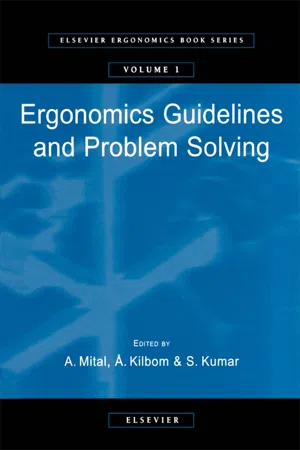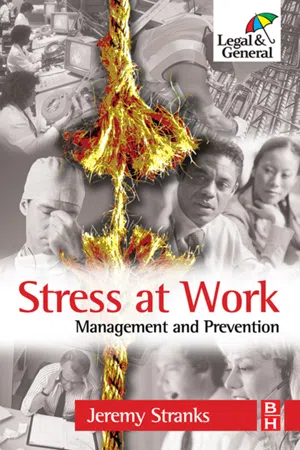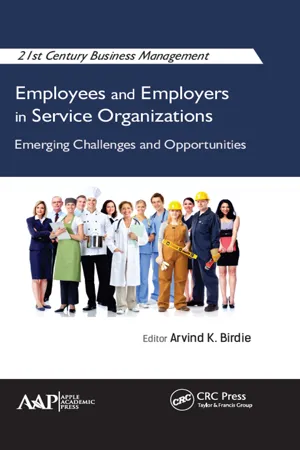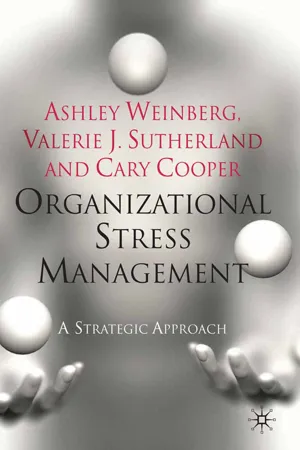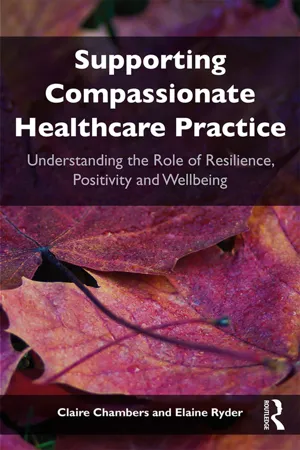Business
Personal Stress Management
Personal stress management involves the practice of techniques and strategies to cope with and reduce stress in one's personal and professional life. This can include activities such as exercise, mindfulness, time management, and seeking social support. By effectively managing stress, individuals can improve their overall well-being and productivity.
Written by Perlego with AI-assistance
Related key terms
Related key terms
1 of 4
Related key terms
1 of 3
11 Key excerpts on "Personal Stress Management"
- Jo Bryson(Author)
- 2017(Publication Date)
- Routledge(Publisher)
Chapter 30 is about career planning and personal development. Employees’ personal satisfaction with themselves, their lifestyle and their work, and their sense of purpose in their career and life goals, can be supported through the activities of career planning and personal development. The chapter looks at the relevant responsibilities for the information service, the information services manager and the individual in career planning. It considers a holistic approach to lifestyle planning using amind map exercise. Managing oneself and personal image is also covered.Figure P7.1 Managing the individualChapter 30 also includes the topic of training. It covers the identification of training needs, designing the training programme, maintaining the behaviour learnt in the training programme and evaluating the training programme. Finally, it considers performance reviews and appraisals to provide feedback to individuals on their performance and as a mechanism for identifying training and personal development needs.Passage contains an image
29Stress management
Introduction
Stress is an environmental force, either real or imagined, that acts on an individual’s tolerance to have a motivational or stimulatory effect. Stress is the response that the human system makes in adjusting to the demands of activating life events. It is not the event itself. The life event is known as the stressor. All individuals are victims of stress: being constantly exposed to life events that are threatening. However, stress tolerances differ between individuals, some being more able to control or manage their responses to stress than others.Stress is not necessarily unhealthy. Everyone needs a certain amount of stress in order to function well. It is constant or excess stress that produces unpleasant or harmful side-effects. If the stressor’s force exceeds the individual’s stress tolerance level it will have a debilitating effect upon the individual.Stress is a physiological state. The conditioned responses to aid the body, characterized by arousal to meet the situational demands and relaxing when the task is accomplished, are natural characteristics of survival in transitory stress-producing situations. If these responses are allowed to accumulate beyond the adaptive capacity of the body they can result in physiological or psychological illnesses. This is because the build-up of physical energy inside the body is inappropriate to the modern life situation. Man is no longer a primitive animal requiring sudden bursts of energy for survival.- eBook - ePub
- A. Mital, Å. Kilbom, S. Kumar(Authors)
- 2000(Publication Date)
- Elsevier Science(Publisher)
For example, Howard et al. (1975) determined that the most successful strategies for coping with stress used by managers were changing to a non-work activity, building better resistance through regular sleep and good health habits, separating work and non-work life, talking with coworkers and engaging in physical exercise. Many of these techniques have been associated with lower stress levels in intervention studies, for example Fremont and Craighead (1987) found that exercise programmes helped to control the level of emotional stress. It should be pointed out, however, that the behaviours shown to be used by individuals who cope successfully with stress tend to be emotion-based strategies which have little effect on min-imising actual exposure to work stressors (Pearlin and Schooler, 1978). Problem-based strategies are needed to cope with the source of stress. This suggests that the strategies that people spontaneously generate to cope do not tackle the real causes of their stress problems, but only help to tolerate them. It can be argued, therefore, that workers need training to help deal with work stressors, but that this training must emphasise problem-based strategies, and it must be linked to other organisational strategies to reduce their exposure to stressors. Implementing individual interventions: Individual stress management in organisations normally takes one or both of two forms, training programmes conducted usually by a consultant expert and Employee Assistance Programmes. The individual stress management strategies described in the preceding discussion would typically be conducted as part of a training programme. Techniques like muscle relaxation, meditation and time management are taught in workplaces often in a general health promotion context rather than in response to a known problem - eBook - ePub
- Jack Dunham(Author)
- 2003(Publication Date)
- Routledge(Publisher)
Chapter 10Stress management
There is growing concern among teachers about the increasing mental, physical and emotional costs of stress at work. Their concern is reflected in the number of objectives related to stress which teachers want to achieve on my management courses, such as learning:- how to avoid stress;
- coping strategies;
- how to help people smile and stay sane;
- how to improve the quality of life within school;
- how to reassure colleagues;
- survival skills;
- how to provide active support for colleagues.
This chapter uses these objectives as its targets and presents a framework to achieve them. Teachers have found it helpful in preparing, developing, practising and monitoring the beneficial effects of personal and whole school stress management programmes and policies. This framework has six parts:- accepting the existence of stress in themselves and their colleagues caused by work pressures;
- learning to understand what stress is;
- beginning to tackle the problem by identifying the work pressures which are sources of stress;
- recognising the signs of stress which are the reaction to these negative pressures;
- identifying the coping strategies and resources which teachers use to reduce work pressures and the signs of stress;
- developing personal and whole-school stress management programmes and policies.
ACCEPTANCE OF STRESS
A primary teacher emphasised the importance of this first step in a stress management programme:A secondary teacher wrote of the stigma which is still associated with stress:I have learned not to be too proud to ask for help. I now know that acknowledging anxiety to yourself and expressing it to the right people is the first step in relieving it. Having had a complete breakdown I would plead with anyone to acknowledge stress long before it gets to that stage.It seems to me that the most important aspect of coping with stress must be the recognition by an individual that stress is part of his/her problem. One’s colleagues in the staffroom exhibit many symptoms which I would now associate with stress. I think that many of the sufferers would deny that they were prone to such weaknesses. - eBook - ePub
- Jeremy Stranks(Author)
- 2005(Publication Date)
- Routledge(Publisher)
Everyone is subject to stress at some time in their lives. It may be associated with a range of incidents and situations, such as loss of a job, death of a loved one, problems at work, bullying and harassment by colleagues at work or simply overloading of the job.People would be much happier if they studied the causes of stress in their lives and adapted appropriate strategies for coping with these stressors. This chapter has provided a number of strategies for coping, including personal relaxation and time management, two important aspects of reducing those occasional crises that arise.Questions to Ask Yourself After Reading This Chapter- What do people need to do in order to cope more successfully with the stress in their lives?
- What does relaxation therapy entail?
- Why can organizational change be a source of stress for everyone?
- What are the effects of change on people?
- How can time management be improved?
- What do people need to do in personal crisis situations?
- Do some people need assertiveness training?
- What forms of relaxation therapy are available?
- How do people cope with changes in their personal lives?
- How do people respond to stress?
Key Points – Implications for Employers- For people to cope with the stress in their lives, they must be aware of those factors which create stress (stressors) and their specific stress responses, such as insomnia, digestive disorders or even aggressive behaviour.
- In order to deal with stress, everyone should be trained to develop their own personal coping strategies.
- Change within the organization, in job content, in the management systems and in working arrangements are some of the greatest causes of stress amongst employees.
- Better time management is one of the best ways of coping with stress at work.
- Some people, particularly those who have to deal with members of the public, may benefit from assertiveness training.
- eBook - ePub
Employees and Employers in Service Organizations
Emerging Challenges and Opportunities
- Arvind K. Birdie, Arvind K. Birdie(Authors)
- 2017(Publication Date)
- Apple Academic Press(Publisher)
The abundance of research on stress theory highlights its importance in our psychological, social, and psychological health (Lazarus, 2006). The human capital of an organization is an appreciating asset and should be managed well. This is particularly so for service organizations which are dependent on their employees for service creation and delivery. All out attempt should be made to maintain and retain the precious human resources of the organization. They should be trained and educated to increase their knowledge and skills to handle the increased demands in this turbulent, hypercompetitive world better. Stress management is vital for an organization to succeed as is evident from numerous studies linking stress to absenteeism, leave, health costs, insurance costs, low morale, and low productivity. The companies cannot ignore the management of stress in organizations as there are huge risks involved with that. In order to reduce leave, absence, and attrition rate, the employee health and morale should be monitored, evaluated, and enhanced. The workplace design should be novel and ergonomic in nature and the work should be structured in such a manner that it does not become a cause of stress. The management policies and practices should be aimed at minimizing the stress levels. Instead of following a rigid approach, some control over their work area should be provided. The channels of communication should be kept open at all times. Employees should feel appreciated and respected while working for the organization. Various techniques for managing stress in the literature and used by practitioners have been analyzed. They can be administered to individuals or groups and comprise of physical, mental, social, and spiritual elements. The eastern nations have a history of spiritual journey and so interventions touching mind, body, and soul have a long-lasting effect on employees. The organizations should focus on the group interventions as they inculcate bonding within the group and facilitates team working. There is no consensus in the literature over the best stress management technique. The organizations even in the developing world are aware of the repercussions of high level of stress in the organizations. The education and awareness campaigns are going on but still stress management is not considered the primary factor for increased productivity. There is no one solution for all the organizations. Each organization needs to identify the bouquet of stress management interventions for its use that best suit the profile of its employees. - eBook - ePub
Job Stress
From Theory to Suggestion
- John M Ivancevich, Daniel C Ganster(Authors)
- 2014(Publication Date)
- Routledge(Publisher)
Murphy's (1984, 1986) reviews of the literature have pointed out a number of important points. First, most of what he refers to as SMT is individually focused. His review includes no studies that attempt to correct, fix, or modify the work or organizational environment that may or may not be a major source of the workplace stress. Second, no theoretical or conceptual model is used by researchers to systematically guide their assessments of the effects of programs on relevant outcomes. Consequently, there is no programmatic effort being undertaken by researchers that addresses well thought out evaluation concerns. Third, long-term effects, if any, of interventions intended to reduce or control stress are not being monitored. Therefore, immediate or short-term benefits of stress management interventions are being used to justify the time and expense. Fourth, white-collar male employees are for the most part the participant group involved in stress management interventions. The physical, chemical, and work environment stressors generally found in blue-collar work environments appear to be ideal targets for stress management interventions. Fifth, the overemphasis on individually oriented stress management interventions has slowed down efforts by organizations to alter work conditions that contribute to stress. Although this argument has been expressed again and again by labor unions it has not been taken seriously by most practitioners who are concerned about the economic, personal, and legal costs of uncontrolled, sustained workplace stress (Neal, Singer, Schwartz & Schwartz, 1984).A Stress Framework
Practicing managers intuitively believe that unchecked stress among their subordinates can reduce performance, create morale problems, and may even contribute to turnover. However, when managers think about stress they generally do not include in their analyses a view of genetic properties, cognitive appraisal mechanisms, physiological responses, or cause and effect linkages. The manager's concept of stress is more personal, less scientifically based, and much more work related. He or she has developed a personal set of beliefs about stress at work and what can be done about it by listening, observing, and talking with colleagues and other employees.If managers are to play a more active role in the diagnosis, implementation, and evaluation phases of any intervention program they need to have a framework that is rigorous enough to guide actions, but practical enough to be meaningful. The framework presented in Figure 1 - eBook - ePub
Organizational Stress Management
A Strategic Approach
- A. Weinberg, V. Sutherland, C. Cooper(Authors)
- 2015(Publication Date)
- Palgrave Macmillan(Publisher)
It is worth remembering that stress and pressure are an inevitable part of living and working, but distress is not! Our lives continue to become more complex. Like death and taxes, organization change will continue to be a feature of life in the twenty-first century and, thus, a potential source of stress. However, it is mismanaged stress that is damaging in its consequences. Both preventive and curative stress management strategies are essential in an organizational approach to stress control in the workplace, with education about psychological health, sound management skills and flexible working at their heart. Increasingly, evaluation studies indicate that prevention is more effective AND cheaper than trying to cure problems and victims of exposure to stress.Undoubtedly, stress management in the workplace must be the joint responsibility of both the organization and the individual. Both parties have a duty of care, and need to exercise this obligation in order to remain healthy and free from harm. Ultimately, the effective management of potential sources of stress is about being in control of the pressures in one’s life. While change will continue to exert a considerable force on our working lives, it must be acknowledged that some degree of pressure is inevitable and can be the spur to improved performance and motivation. Stress is a dynamic process, and this means that strategic stress management is not a one-off project. It must become an ongoing process within the organization based on awareness, analysis and action. To be successful, it must become part of day-to-day management and practice, and embedded within the culture of the organization. Ultimately, this is the only effective and cost-efficient strategy to avoid the unacceptable costs of distress in the workplace.We need to understand the nature of stress at work before we can eliminate or moderate it. A stress control program can be effective, if resources are targeted to specific problems and aimed at the elimination of the source of stress. Those organizations that recognize the high costs of mismanaged stress in the workplace, and seek to achieve enhanced levels of effectiveness and the well-being of their workforce, will adopt this integrated approach to stress management. It embraces both individual coping and organizational change to combat the problems associated with stress at work. If we can successfully coordinate both levels, we might be able to enact the words of Gandhi and “Be the change you wish to see in the world.” - eBook - ePub
- Karl Albrecht(Author)
- 2010(Publication Date)
- Touchstone(Publisher)
From the point of view of the people who manage any organization, stress arises in two ways. First, they themselves as normal human beings experience pressure as a basic part of their own jobs. If they find themselves struggling with intolerable levels of stress, then they are paying too much in terms of their own health and well-being for the satisfactions they are getting. The quality of their own lives will not be what it should, and they will not be able to function as effectively as they should. They lose, and the organization loses. Second, if the workers of the organization experience intolerable levels of stress, then their lives will lack the quality to which they are entitled, and they too will not function as effectively as they should. Because managers have the special job of deciding and directing action, they—not the workers—have most of the opportunities to take the stress factor into account in daily business and to take constructive action toward stress reduction and stress management.In this sense, every manager from top executive down to first-line supervisor finds himself faced with the need for a two-pronged approach to stress. He must first develop the necessary skills for reducing and managing the stress he himself feels in carrying out a challenging management job, and he must find ways to help the employees reduce and manage the stress they feel. This approach implies both a set of personal psychological skills on the part of managers and employees alike and an environment that they have jointly constructed and maintained to elicit human performance without the avoidable side effects of stress.STRESS AND THE EXECUTIVE
Executive health and well-being are among the most critical resources available to an organization. A great portion of any organization’s effectiveness derives directly from the personal effectiveness of the small number of people at the top. Those who set strategy, decide on major courses of action, allocate its major resources, and take the risks in guiding the organization invest themselves as human beings as well as merely their talents. - Rabi S. Bhagat, James Segovis, Terry Nelson(Authors)
- 2016(Publication Date)
- Routledge(Publisher)
The focus of much of stress literature has been on symptom management, whether psychological and physiological (Lazarus & Folkman, 1984). How we manage our somatic health is critical. Otherwise, we will enter a negative spi-raling loop with our health symptoms compounding the various situational problems we need to solve. Our struggles with specific stress illnesses, such as stomach ulcers or depression, will become an added burden as we confront the daily source of the stressors. As we lose critical health resources, we will struggle even more with our depleted energy base or attempt to conserve what we have through passive strategies (Hobfoll, 1989; Hobfoll & Shirom, 1993). Within organizational research, there is a dominance of secondary and tertiary symptom management interventions. Fortunately, a number of these interventions gives us a wide body of effective strategies to reduce and treat any harmful somatic and psychological effects, if only in a reactive fashion. Organizational wellness programs, though, have evolved as a secondary stress management intervention to be a valuable tool in this process (Bennett, Cook, & Pelletier, 2011). Of course as discussed earlier in this chapter, this depends on how seriously companies intend to integrate these practices into the fabric of their management systems to create a healthy workplace to assist workers’ symptom management.This transformative model of stress management then offers a comprehensive and dynamic framework to explain why specific interventions are more successful than others. The more a stress management strategy addresses the issues of mastery, meaning, social-community connections, positive self-regard, and symptom management, the more likely it will promote psychological and physical well-being. In essence, as each component of the model increases in use, it then builds an overall sense of coherence for individuals where their lives can be seen as comprehensible, manageable, and meaningful (Antonovsky, 1987, 1993). There exists a pervasive feeling that your life is predictable and you have the necessary resources to engage your environments’ demands as challenges. At a macrolevel, this model also explains why many of the primary and sec-ondary interventions developed by organizations have achieved mixed results. In many situations, management’s leadership has not fully enabled workers to have the ability to master their situations, create meaningful work, or build a sense of community. It is then left to the employees to cope with this process with the numerous barriers placed in their way. Tertiary interventions remain then the only option at this point to treat the dysfunctional consequences of the distress. Fortunately, this negative scenario does not necessarily have to occur as frequently as it does. Fortune magazine’s Top 100 Companies To Work For issue each year clearly illustrates along with the winners of such awards as the Corporate Health and Productivity Management Awards- eBook - ePub
Supporting compassionate healthcare practice
Understanding the role of resilience, positivity and wellbeing
- Claire Chambers, Elaine Ryder(Authors)
- 2018(Publication Date)
- Routledge(Publisher)
3 The Benefits of Effective Stress Management StrategiesOverview of the chapter Case Study Discussion: how do we manage stress in our lives • What is stress? • Signs of stress and negative coping strategies • Emotional labour • Particularly challenging situations • Is distancing ourselves from the people in our care the answer to reducing our stress? • Emotional burnout • Stressful care environments • Causes of stress • The costs of stress Implications for us as leaders Thoughts for your practice Summary References Overview of the chapter
So what is stress, and what are its causes and manifestations, and what are the costs of stress in today’s world to us as individuals, and to those in our care? We discuss negative coping strategies and how these relate to emotional labour and to particularly challenging health care situations. Distancing ourselves from the people in our care does not reduce stress and can lead to greater emotional burnout, and we need to recognise this in ourselves and others. We discuss positive stress management strategies and the benefit of mindful communication approaches. Stress reduction strategies enhance our empathy and enable us to make meaningful relationships with patients which decreases our likelihood to experience burnout.Health care environments are innately stressful because they involve caring for people who are distressed, acutely or chronically unwell and at very stressful points in their lives. In addition, we are all busy people living with lives that are busy and challenging, with many different pressures on us, and this can all seem like too much to cope with at times. If we add in the stress of working in very busy environments, with constant, and often unachievable, deadlines, and real constraints on our time, then it is not surprising that stress is endemic within our personal and professional lives. - eBook - ePub
De-Stress at Work
Understanding and Combatting Chronic Stress
- Simon L. Dolan(Author)
- 2023(Publication Date)
- Routledge(Publisher)
Nevertheless, and in contrast to what has been held as fact for many years, we consider that these are not enough. Increasingly, more data is being revealed confirming the enormous relationship that stress has with organizational and work factors, for instance: organizational culture, the type of structure adopted by the company, the leadership style exerted, and how jobs are designed, amongst others. Is it enough for workers to practice relaxation techniques and/or improve time management? We are inclined to consider that they are necessary but insufficient, since these types of actions imply involvement only at an individual level though stress also has an organizational component. Interesting to Know Anna Diamantopoulou, Former European Commissioner for Employment and Social Affairs: “It is necessary for all the interested parties to recognize that occupational stress is a real risk and one that is deeply rooted in the workplace. Industrialists, workers, and governments will have to step up preventive measures in this field. Good stress management practices in the workplace are required for tackling this ever-increasing problem”. Because we are aware of the fact that an entire book can be written on almost each remedy offered, we realize that the presentation and discussion will be brief and perhaps incomplete. Recently, we have published an interesting (albeit philosophical) paper of the “design of life”. 1 It is worthwhile reading hence we claim that a person can control to a great extent his/her level of stress by planning respective life philosophy, where needs, desires, talent, work setting and family setting are considered altogether. We will elaborate a bit more on this concept in our last chapter where we discussed the future
Index pages curate the most relevant extracts from our library of academic textbooks. They’ve been created using an in-house natural language model (NLM), each adding context and meaning to key research topics.
Explore more topic indexes
Explore more topic indexes
1 of 6
Explore more topic indexes
1 of 4

